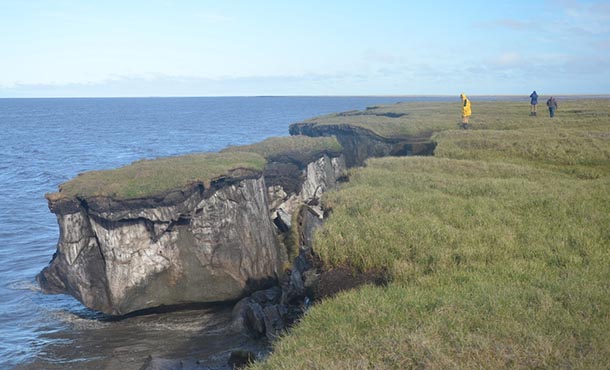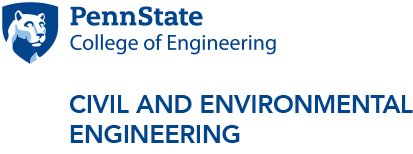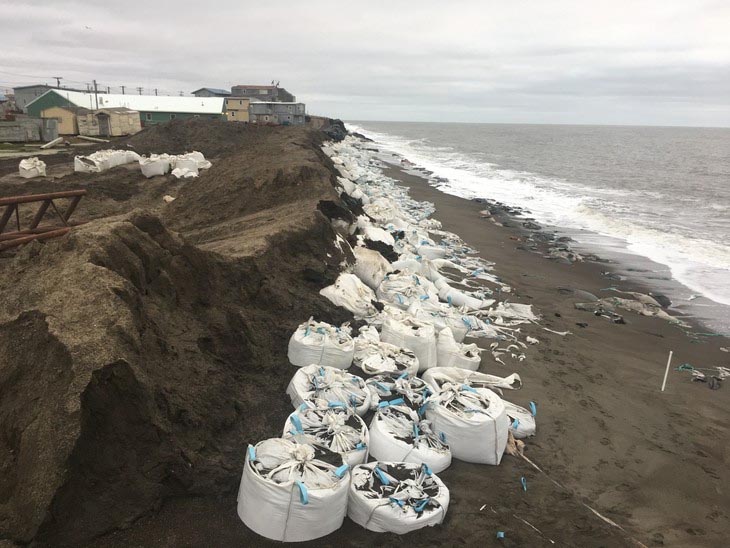
As temperatures rise, the frozen ground of the Arctic coastline is melting, wrecking havoc on the infrastructure and communities of the coast. IMAGE: BENJAMIN JONES, UNIVERSITY OF ALASKA FAIRBANKS
Civil engineer leads $3M project to study eroding Alaskan coastline
10/3/2019
By Ashley WennersHerron
UNIVERSITY PARK, Pa. — The Arctic sea is consuming Alaska’s coastline. Since 1955, the rising water has eroded more than 300 meters of permafrost — the frozen soil that helps protect the Arctic’s delicately balanced ecosystem. It also serves as the foundation upon which hundreds of villages and thousands of people exist.
A collaboration of universities, led by Penn State’s Ming Xiao, associate professor of civil and environmental engineering, is now working to understand exactly how the degradation will immediately affect the Alaskan communities and, eventually, the rest of the world. The National Science Foundation awarded the project $3 million, with a third of that going to Penn State. Xiao’s Penn State team includes Christopher McComb, assistant professor of engineering design and mechanical engineering.
The rest of the funding will support work by Vladimir Romanovsky, professor of geophysics at the University of Alaska Fairbanks; Xiong Zhang, associate professor of geotechnical engineering at the Missouri University of Science and Technology; and Lilian Alessa, professor of landscape architecture and co-director of the Center for Resilient Communities at the University of Idaho.
“What happens in the Arctic does not stay in the Arctic,” Xiao said. “Permafrost contains double the carbon currently in our atmosphere. As it melts and degrades, that carbon can be released, causing more melting and degradation, affecting even more of the globe.”
The problem is so dire that the National Science Foundation established “Navigating the New Arctic” (NNA) as one of its Ten Big Ideas. Through the NNA, the NSF awarded $35 million in grants to researchers across the United States focused on understanding the impacts of global warming in the Arctic this year.
“Our project has three main focuses,” Xiao said. “We are working to understand how the ground is changing as it thaws, how the changing ground affects the infrastructure along the Alaska coast, and how these changes influence the social system of the people living in these areas.”
Each university involved will develop individual predictive models of how one factor may evolve as temperatures and sea levels continue to rise. Xiao and his team at Penn State will combine the individual models into one, which researchers can use to explore how one factor can influence the others, or how multiple factors can have different effects when compiled together. Currently, the connection between the physical degradation, the infrastructure and the social systems in an area directly impacted by climate change is not well understood, but the effects are certainly being felt.
“In Alaska, the ice used to be thick enough for people to drive across it,” Xiao said. “That is not the case anymore. People have fallen through the ice and have never been recovered. The people who live there, their homes are falling into the ocean as the coast erodes. Their way of life is disappearing.”
Individuals in the communities most affected can move, but, according to Xiao, they are losing much more than property.
“It is not just the cost of physically moving,” Xiao said. “They are losing thousands of years of tradition and culture. They are not just losing houses — they are losing their homes, their families.”
Xiao also was recently awarded another NSF grant of $1.8 million as a co-principle investigator. The grant is led by Benjamin Jones at the University of Alaska Fairbanks. Together, they will develop an international network that allows Arctic coastal communities to exchange information about the fundamental knowledge gaps in the science, engineering and societal issues associated with the continued degradation of permafrost.
Xiao said the physical cost of warming is not limited to the Arctic, and eventually, everyone will feel the effects of the melting Arctic.
“In 80 years, it is predicted the Arctic will be a wet, grim place,” Xiao said. “At the same time, the ocean will continue to rise due to the melting ice in the polar regions, drastically changing New York, Florida — coastal cities across the world.”
Currently, one area most affected is the Arctic coastal city Utqiaġvik, previously known as Barrow. It is the northernmost city in the United States, and one of the northernmost cities in the world. The city is currently using sandbags to shore up its coast, which has unintended consequences.
“The sea is brutal,” Xiao said. “The waves are powerful, and they contain loose chunks of ice. They slam into the bags and shred them, which negates their barricading capabilities. Then the shreds end up entering the sea water.”
Over the next five years, the researchers will merge the models to provide precise data on how continued climate change will affect the coastal erosion, the infrastructure and the social systems.
“We hope this model can have a real impact on decision making when it comes to preventing further damage,” Xiao said.




